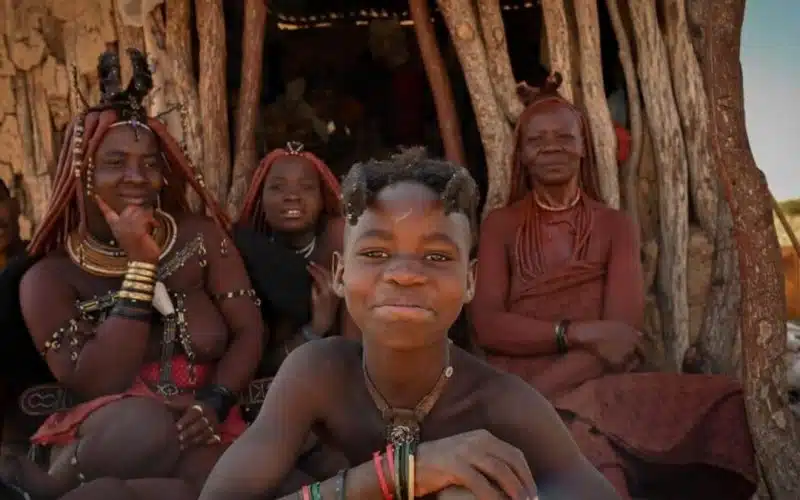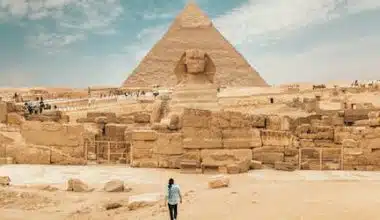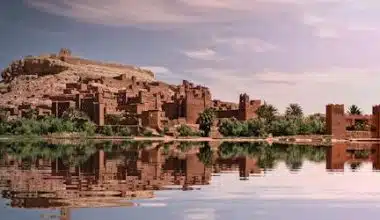The Himba tribe is probably the most well-known of Namibia’s ethnic groupings. Their photos are often exploited to promote the country, but they account for only one or two percent of the population. Read on to learn more exciting facts about the Himba tribe woman, what she eats, and the style of their clothing.
They are a semi-nomadic tribe that survives by herding and rearing sheep, cattle, and goats. The women are noted for using otjize, a mixture of butterfat and ochre that gives their complexion and plaited hair a crimson color. Both men and women traditionally go topless and wear skirts or loincloths made of animal skins. Modern clothing is scarce, but when it is available, men wear it most frequently.
We’ll tell you about the Himba tribe, what to expect when visiting one of their towns, and why this is a must-see location.
Himba Tribe
The Himba are possibly the most well-known of Africa’s tribal groupings. The tribe is known for their distinctive adornments and their unwavering dedication to tradition. The tribe’s women are bare-breasted and highly adorned with symbolic jewelry. They wrap their bodies in ‘otjize,’ a reddish-colored mixture of animal fat and ochre.
These cattle-herding tribes have traditionally lived in wooden huts encircling a sacred ancestral fire, and their everyday lives revolve around rearing and herding livestock.
The Himba have long avoided contact with the modern world, living tranquil lives of pastoral cattle-herding in a bleak region of north-western Namibia. There is no information about the inhabitants of Kaokoland before the first European expeditions to the remote region because the West did not directly influence the region until well into the twentieth century.
As a result, the Himba people are frequently described (particularly in modern tourism brochures) as timeless and archaic, embodying a ‘lost’ or ‘old’ African age.
Himba Tribe Woman
The Himba tribe, which lives in Namibia’s Kunene area, is known for its rich cultural history and traditional way of life. Among the many things that captivate the Himba people, the role and customs of Himba women are particularly intriguing.
The Himba woman stands out because of her appearance. They cover their bodies in otjize, a red ochre paste derived from butterfat and ochre. Otjize is a moisturizer, sunscreen, and insect repellant all in one. It also imparts a characteristic reddish-orange shine to the women’s skin.
The following are some amazing facts about Himba women and their unique rituals that have preserved their culture for centuries:
#1. Otjize and Adornments
The Himba women are well-known for their remarkable looks. They cover their bodies in otjize, a red ochre paste derived from butterfat and ochre. This mixture moisturizes, sunscreens, and repels insects while also giving their skin a characteristic reddish-orange hue. In addition, Himba women wear sophisticated hairstyles and jewelry, such as necklaces, earrings, and bracelets made of beads and shells.
#2. Matrilineal Society and Women’s Role
Property and inheritance are passed down through the female line in the Himba people’s matrilineal system. Women play an important role in the community, as they are in charge of daily duties like cooking, cleaning, and raising children. Their efforts are critical to the proper operation of Himba homes as well as the preservation of traditional practices.
#3. Skilled in Traditional Crafts
Himba women are excellent at traditional crafts such as basket weaving and ceramics. Their handicraft reflects their profound cultural traditions and serves as a form of artistic expression. These elaborate constructions have cultural and symbolic importance to the Himba people in addition to being useful.
#4. Spiritual Significance
Himba women have an important part in the tribe’s spiritual life. They take part in rituals, ceremonies, and traditional customs to protect spiritual beliefs and ancestral traditions. Their spiritual counsel and involvement help the Himba community’s cohesion and well-being.
#5. Hospitality and Sense of Community
Himba women are recognized for their welcoming grins and friendly friendliness. They have a strong sense of community and are skilled at creating a supportive and welcoming environment. Visitors to Namibia are invited to experience the hospitality of the Himba people directly, as it provides a unique insight into their way of life.
Clothing for the Himba Tribe
Himba women’s traditional dress is decidedly revealing; they only wear a simple skirt of ombuku goat hide, leaving their breasts exposed, and wearing leather shoes.
Men also wear skirts, though the goat skin is frequently replaced with more modern textiles, and they are paired with non-traditional clothes, such as shirts or jackets that contrast with the surrounding landscape.
The Himba women enjoy wearing large adornments, which are mostly made of leather, iron, or copper and are adorned with bone fragments. The most essential and valuable jewelry is given to the mother after the birth of her first child. It is an ohumba necklace, which consists of a huge white shell, a symbol of fertility; the shell originates from Angola and is worn between her breasts.
Hair and hairdressing are important among the Himba because they indicate each individual’s social status within the community. Young girls used to dress their hair with two braided hair plaits extending forwards, whereas after puberty, hair is worn down and numerous rasta braids are made and covered with the same butter and ochre paste used for the body.
Facts about the Himba Tribe
Namibia’s Himba tribe, like other African tribes, has a distinct culture that they acquired from their forefathers. While some features of their culture are comparable to those of other global tribes, they also have cultural characteristics that other tribes do not practice. However, as a result of the problems brought by modernity, several cultural practices are gradually slipping away.
What is the Himba famous for? As Namibia’s only semi-nomadic herder community, the Himba culture has drawn international attention from those interested in learning about and preserving history. Some notable facts about this lovely culture include:
#1. The Ovahimba Do Not Bathe
Because they live in a desert where water is scarce, the OvaHimba people do not bathe. When they want to clean their bodies, they instead use smoke. Herbs are used to do this. In a small basin, they first added some plants and leaves before adding smoldering charcoal. They then placed the bowl close to their bodies for the heat and smoke to get them to sweat.
#2. The Himba worship Mukuru
OvaHimba are very religious, and Mukuru is their god. They believe that their god is busy in another place, so they must travel to their ancestors as Mukuru’s ambassadors. Their dwellings are typically designed to be built around an ancestral fire (okuruwo) and their livestock. These two factors are important to their ancestral worship beliefs. Cows indicate proper interactions between individuals and their ancestors, whereas Okuruwo denotes ancestral guardianship.
#3. They Have Unique Hairstyles for Men and Women
A single Himba ethnic man is riding his motorcycle in Cunene Province, Oncocua. Photographer: Eric Lafforgue Getty Images is the source for this image. The Himba people’s hair is one of their most distinguishing characteristics. The Himba tribe’s hair is more than just a fashion statement. They all have different hairstyles and various meanings.
Hairstyles, for example, can be used to signify variations in age and socioeconomic status. Young girls typically have two plaits of braided hair, known locally as ozondato. The patrilineal descent group to which a girl belongs determines the shape of the plaits. When the girls reach adolescence, they wear long plaits that dangle loosely over their heads. They can also take several shapes. Some girls, for example, like to wear wigs over their plaits.
#4. The Himba Jewellery Represents Ancient Customs
People nowadays buy jewelry solely for its aesthetic value, with no regard for its cultural significance. Even though OvaHimba’s jewelry contributes to superficial aesthetics, it usually has a deeper message.
Most of their jewelry is embellished according to traditional practices. Both men and women are accustomed to wearing several necklaces and arm bracelets, some of which extend the full length of their arms. Copper, grass, ostrich eggshell beads, and cotton are used to make the bracelets. The bracelets can be as heavy as 40 kilograms.
#5. They Use Red Ochre to Protect Their Skins from the Sun
The Himba people’s red skin is one of their most noticeable characteristics. Their skin, however, is not red. The Himba tribe’s color experiment demonstrates that a mixture of red ochre, butter, and fat is responsible for the appearance. The shards are then combined with butter, which is then slightly cooked with smoke.
#6. Ovahimba Offers Sex to Guests
Offering sex to visitors is a widespread practice among the Himba. This is referred to as “okujepisa omakazendu,” which translates as “offering wife to guest.” To demonstrate that his guest is cherished and welcome, a man will allow his wife to lie with him for the night.
He will have to sleep outside if he cannot find another residence to stay in for the night. This lowers jealousy and promotes friendly connections.
#7. The Himba originated from Angola
The Himba tribe has not always lived in Namibia. They are claimed to have arrived in the Kunene region in the 1500s from Angola. Originally, the Himba belonged to a tribe known as the Herero. However, the Herero tribe was forced to split into separate tribes due to a severe shortage of cows.
While most people traveled south in search of a land where their remaining cows could thrive, some chose to remain in the hope that better days were approaching. Those who stayed were given the moniker Himba, which means beggar in Swahili. When they were left behind, they had to go around neighboring villages, asking other tribes for aid with cattle and crops.
#8. They Never Go a Day Without Porridge
Porridge is something OvaHimba can never go a day without eating. As a result, they consume porridge at least twice a day, in the morning and evening. To make the porridge, heat the water until it boils.
They next add flour (maize or millet) and, on occasion, oil. After that, the mixture is mixed until it is ready to serve. Meat is a rare pleasure for them, eaten exclusively on exceptional occasions such as weddings.
#9. Polygamy Is a Common Practice Among Himba People
Polygamy is common among the OvaHimba. It is a patriarchal society, which explains why the Himba tribe women tend to the homestead and perform the majority of hard labor activities. A man can marry numerous women because women are seen as helpers who perform jobs.
The majority of Himba women are married off at an early age. Their fathers plan to marry them off as soon as puberty begins.
#10. Their Homesteads Are Built on the Edge of the Village
Himba homes are cone-shaped structures built on the outskirts of the community. A central kraal supports the mud, mopane trees, and cow dung structures. The villagers think there is a sacred line that connects them at the main kraal gate, which leads into the chief’s hut. The holy fire ‘okuruwo’ is positioned in the village’s heart. All hut doors must be facing away from the community.
What Is the Himba Tribe Known For?
The Himba are a semi-nomadic tribe that has lived for millennia in northern Namibia. Along with their deeply ingrained cultural customs and beliefs, they stand out for their striking red ochre body paint and ornate jewelry.
Which Tribe Offers Wife to Guest?
Himba Tribe: An African tribe that provides guests with wives.
What is the Himba tribe’s occupation?
They are a semi-nomadic tribe that survives by herding and rearing sheep, cattle, and goats. The women are noted for using otjize, a mixture of butterfat and ochre that gives their complexion and plaited hair a crimson color.
What do the Himba eat?
The Himba typically consume cornflower-based gruel, with meat such as cattle, goats, and springbok eaten once every two weeks.
In the Himba Tribe, What Age Do People Marry?
They conduct arranged marriages at a young age. Young Himba females are married to men selected by their fathers. This occurs at the onset of puberty, which may result in girls as young as 10 being married off.
Which African Tribe Is the Most Beautiful?
The Himba are sometimes referred to as Africa’s most attractive tribe. Their otjize-coated hair and skin give them a perfect, luminous complexion, while their slim frame and upright posture give them an unearthly elegance.
Summary
Namibia is well-known for its stunning landscapes, diversified wildlife, and lively culture. The Himba are one of the country’s most unique and diverse cultural groupings. If you’re planning a Namibian safari, you should include a visit to a Himba community on your schedule.
- The Rich Cultural Heritage of Himba Tribe Women
- AFRICAN VACATIONS: Top Destinations & Packages
- AFRICAN ANIMALS: A Journey Through the Wild Heart of Africa
- SAN PEOPLE OF AFRICA: History & Rich Cultural Heritage






